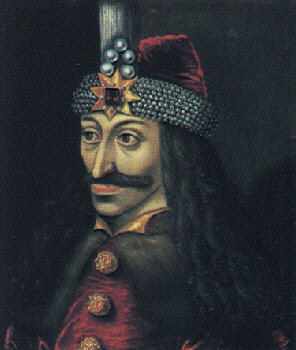VLAD TEPES: DRACUL
1431-1476

 Vlad Tepes (pronouched tse-pesh), born in a Transylvanian town called Sighisoara, lived from 1431-1476, a short lifetime indeed when compared to his later "incarnation" as Count Dracula in Bram Stoker's famous 1897 novel (coincidentally, Joan of Arc was burned at the stake in 1431). He was born into the Basarab family, the son of Vlad II.
Vlad Tepes (pronouched tse-pesh), born in a Transylvanian town called Sighisoara, lived from 1431-1476, a short lifetime indeed when compared to his later "incarnation" as Count Dracula in Bram Stoker's famous 1897 novel (coincidentally, Joan of Arc was burned at the stake in 1431). He was born into the Basarab family, the son of Vlad II.
He was a prince of Wallachia, with the title of voivode, Russian for warlord or prince, and history has given him two opposing faces: In Romania, he is hailed as a national hero, as the ruler who defeated the dreaded Ottoman Turks and who resisted Hungarian ascendency with fierce independence; in the rest of Europe and the world, he is known as "Vlad the Impaler", a true title for this prince of terror that was spread by the propaganda of several writers throughout the centuries. His father was Vlad Dracul, a soldier who commanded one of the units guarding the Wallachian-Transylvanian border, which was susceptible to attacks from both Turks and Hungarians. Dracul is thought to derive from either the Romanian word for devil, or from the knightly order of dragons that Daddy Dracul pledged his loyalty to. An interested reader, Daemon866, informs me that the name of Dracul was assumed after Daddy Vlad entered the Dragon order. And Dracula means "son of the dragon", much like adding son to John (Johnson): therefore Vlad the son was called "Dracula". The elder Vlad, already formidable, was named Prince of Wallachia when the younger Vlad was five. The family moved to Tirgoviste. Obeying the terms of a treaty made with the Turks, his father was obliged to send Wallachian men to the Turkish army. And he sent two of his three sons as hostages to the Sultan. Twelve year-old Vlad was the middle son, nine year-old Radu the youngest. They spent four years as hostages, learning harsh rules of terror, oppression and humiliation. 1447: Vlad's father died, murdered near Bucharest. His older brother, Mircea, was buried alive in Tirgoviste. 1448: Vlad ascended to brief power over Wallachia, with approval of the Ottoman Empire, but had to retreat to Moldavia (with his cousin Stephen) and Hungarian protection when he was overthrown as ruler after just two months. He spent three years there. 1451: Stephen's father, the Prince of Moldavia, was assassinated. Vlad returned to Wallachia, surrendering to Janos Hunyadi, the Hungarian responsible for his father's death. He pledged loyalty to Hunyadi and his life was spared. The following year, he became commander of the forces defending Wallachia. 1456: Hunyadi died of the plague. 1456 - 1462: Vlad once again became Prince of Wallachia. In this timespan, he married (his wife's name is unknown) and he ended the draft of youths into the Turkish army, redistributed land to the peasants and built many churches. But he also used slave labor to build Castle Dracula, and massacred thousands of his subjects and enemies. His favored method was the stake, which is the reason for his historical title Tepes, Impaler. In six years, it has been estimated that he had 75,000 to 100,000 people impaled. 1462: Vlad invaded Turkish territory and they counter-attacked at Tirgoviste. He lost the battle, retreating to his castle at Capatineni, on the Arges River in the Carpathians. His wife believed there was no escape from the Turks, so she committed suicide here. Vlad fled through a secret passage, to once again seek Hungarian protection. King Matthias Corvinus (the son of Janos Hunyadi) imprisoned him, however, knowing his cruel willpower and restlessness. His brother, Radu, was named as puppet Prince of Wallachia by the Turks. He was kept under "open arrest" for four years at Brasov, being locked up only at night. Vlad asked to marry one of King Matthias' sisters. The King allowed it, on the condition that Vlad renounce his Orthodox faith for Catholicism, which he did. He was also appointed as a captain in the Hungarian army. 1474: Vlad was freed twelve years later, but he had to wait until November of 1476 to assume the rank of voivode once again. He was campaigning with his cousin, now called Stephen the Great, to retake Tirgoviste and depose his brother during this time. He moved to the new capital of Bucharest. But his enemies were too numerous for his guaranteed survival, and he was murdered. His headless body was found shortly after Christmas, 1476, not far from the Island of Snagov near Bucharest. He was reportedly buried in the chapel of a monastery on the island. Excavations in 1931, however, only revealed the skull of a horse or ox. A second grave revealed a skeleton and other items, but without definite proof as to who was buried there, the final resting place of Vlad the Impaler remains a mystery. |

| |Vampires: Fang and Horror| |
|The Library| |Bram Stoker| |"Dracula's Guest"| |"Dracula" by Bram Stoker| |Quotes from "Dracula"| |"Carmilla"| |"The Sussex Vampire"| |Hungary| |Elizabeth Bathory: Blood Countess| |Romania| Vlad Tepes: Dracul |
|In a Welcoming Vein: Vampire Renaissance map|
+ + +
|The Entrance Gate|
 
|
07.03.03
Graphics by Dracowylde
Vampires Then and Now
